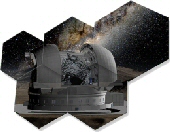Italiano:
I Montes Alpes, sono una catena montuosa situata sulla superficie della Luna, nella parte settentrionale dell’emisfero di cui possiamo goderne la vista da Terra.
Questa catena montuosa, costituisce il margine nordorientale del Mare Imbrium (Mare della Pioggia), distesa di lava pianeggiante e priva di caratteristiche morfologiche di rilievo particolare; più ad est, invece, è situata un’area di crosta lunare continentale, più irregolare e corrugata, con un’albedo superiore.
Vicino all’estremità orientale del cratere Plato, che si trova esattamente subito fuori il margine sinistro di questa mia ripresa, sono collocati i vistosi corrugamenti noti come “Rimae Plato”, qui visibili sulla sinistra dell’immagine, come fratture sinuose.
A circa un terzo dell’estensione della catena, partendo tuttavia da sudest, è collocato il “Mons Blanc” (visibile in basso al centro in questa mia immagine), il rilievo più elevato della catena, che raggiunge i 3,6 km di altezza (contro gli 1,8-2,4 km che caratterizzano le altre cime dei Montes Alpes).
La catena di montagne è interrotta a circa un terzo della sua estensione dalla bellissima “Vallis Alpes”, una valle di frattura della crosta lunare particolarmente ampia che prosegue in direzione est fino a raggiungere l’estremità est del Mare Frigoris (o Mar del Freddo), con una lunghezza complessiva di circa 166 km ed una larghezza massima di 10 km.
Al centro di questa valle scorre una stretta fenditura, dello spessore di parecchie centinaia di metri (qui visibile obliquamente al centro dell’immagine), che non è osservabile attraverso piccoli telescopi.
Infine, una particolarità in questa area, è che L’alba e il tramonto si verificano prima dei rispettivi “quarti lunari”.
Dettagli tecnici:
Telescopio Astrofaktoria DK20 @ ~ F/19 – Baader FFC Multiplier – Baader IR 685nm filter – GS3-U323S6M-C camera – Seeing 6,5/10 in IR band – sito: Palermo @ my personal Observatory
English:
The Montes Alpes, are a mountain range located on the surface of the Moon, in the northern part of the hemisphere which we can enjoy the view from Earth.
This mountain range constitutes the northeastern edge of the Mare Imbrium (Sea of the Rain), an expanse of flat lava and devoid of particular morphological features; further east, however, there is an area of continental lunar crust, more irregular and corrugated, with an upper albedo.
Near the eastern end of the Plato crater, which is located exactly immediately outside the left margin of this shot of mine, there are the showy corrugations known as “Rimae Plato”, visible here on the left of the image, as sinuous fractures.
About a third of the extension of the chain, starting from the southeast, there is the “Mons Blanc” (visible in the lower center in this image of mine), the highest relief of the chain, which reaches 3.6 km in height (against the 1.8-2.4 km that characterize the other peaks of the Montes Alpes).
The mountain range is interrupted at about a third of its extension by the beautiful “Vallis Alpes”, a particularly wide fracture valley of the lunar crust that continues eastwards until it reaches the east end of the Mare Frigoris (or Cold Sea) , with a total length of about 166 km and a maximum width of 10 km.
At the center of this valley runs a narrow slit, several hundred meters thick (visible obliquely in the center of the image), which cannot be observed through small telescopes.
Finally, a peculiarity in this area is that sunrise and sunset occur before the respective “lunar quarters”.
Technical details:
Astrofaktoria DK20 telescope @ ~ F / 19 – Baader FFC Multiplier – Baader IR 685nm filter – GS3-U323S6M-C camera – Seeing 6.5 / 10 in IR band – site: Palermo @ my personal Observatory


